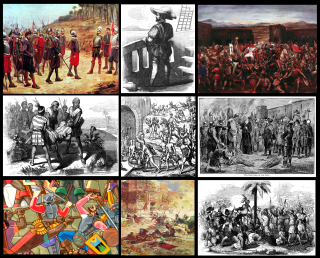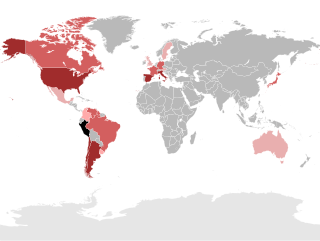
Cusco or Cuzco is a city in southeastern Peru near the Sacred Valley of the Andes mountain range and the Huatanay river. It is the capital of the Department of Cusco and of the Cusco Province. The city is the seventh most populous in Peru; in 2017, it had a population of 428,450. Its elevation is around 3,400 m (11,200 ft).

Lima, founded in 1535 as the Ciudad de los Reyes, is the capital and largest city of Peru. It is located in the valleys of the Chillón, Rímac and Lurín Rivers, in the desert zone of the central coastal part of the country, overlooking the Pacific Ocean. The city is considered the political, cultural, financial and commercial center of Peru. Due to its geostrategic importance, the Globalization and World Cities Research Network has categorized it as a "beta" tier city. Jurisdictionally, the metropolis extends mainly within the province of Lima and in a smaller portion, to the west, within the Constitutional Province of Callao, where the seaport and the Jorge Chávez Airport are located. Both provinces have regional autonomy since 2002.
Peruvian culture is the gradual blending of Amerindian cultures with European and African ethnic groups. The ethnic diversity and rugged geography of Peru allowed diverse traditions and customs to co-exist. Peruvian culture has been deeply influenced by Native culture, Spanish culture, and African culture. Other minor influences on their culture are Chinese, Japanese, and other European peoples.

Peru, officially the Republic of Peru, is a country in western South America. It is bordered in the north by Ecuador and Colombia, in the east by Brazil, in the southeast by Bolivia, in the south by Chile, and in the south and west by the Pacific Ocean. Peru is a megadiverse country with habitats ranging from the arid plains of the Pacific coastal region in the west to the peaks of the Andes mountains extending from the north to the southeast of the country to the tropical Amazon basin rainforest in the east with the Amazon River. Peru has a population of over 32 million, and its capital and largest city is Lima. At 1,285,216 km2, Peru is the 19th largest country in the world, and the third largest in South America.

Sinchi Roca, Sinchi Rocca, Cinchi Roca, Sinchi Ruq'a or Sinchi Ruq'a Inka was the second Sapa Inca of the Kingdom of Cusco and a member of the Hurin dynasty.

The Spanish conquest of the Inca Empire, also known as the Conquest of Peru, was one of the most important campaigns in the Spanish colonization of the Americas. After years of preliminary exploration and military skirmishes, 168 Spanish soldiers under conquistador Francisco Pizarro, along with his brothers in arms and their indigenous allies, captured the Sapa Inca Atahualpa in the 1532 Battle of Cajamarca. It was the first step in a long campaign that took decades of fighting but ended in Spanish victory in 1572 and colonization of the region as the Viceroyalty of Peru. The conquest of the Inca Empire, led to spin-off campaigns into present-day Chile and Colombia, as well as expeditions to the Amazon Basin and surrounding rainforest.

José Sabogal was a Peruvian painter and muralist who was "the most renowned early supporter" and thus a leader in the artistic indigenist movement of his country. As Daniel Balderston, Mike Gonzalez, and Ana M. López assert, Sabogal "became Peru's militant indigenist and aesthetic nationalist, and led this movement for the next thirty years.

Francisco Álvarez de Toledo, also known as The Viceroyal Solon, was an aristocrat and soldier of the Kingdom of Spain and the fifth Viceroy of Peru. Often regarded as the "best of Peru's viceroys", he is as often denounced for the negative impact his administration had on the Indigenous peoples of Peru.
Peruvian art has its origin in the Andean civilizations. These civilizations rose in the territory of modern Peru before the arrival of the Spanish.

Blas Valera (1544-1597) was a Roman Catholic priest of the Jesuit Order in Peru, a historian, and a linguist. The son of a Spaniard and an indigenous woman, he was one of the first mestizo priests in Peru. He wrote a history of Peru titled Historia Occidentalis which is mostly lost, although the Inca Garcilaso de la Vega quoted some of it in his General History of Peru. In 1583 Valera was jailed by the Jesuits. The Jesuits claimed they were punishing Valera for sexual misconduct but more likely the reason was heresy. Valera's writings claimed the Incas were the legitimate rulers of Peru, the Inca's language, Quechua, was equal to Latin as the language of religion, and the Inca religion had prepared the Andean peoples for Christianity. In 1596, still under house arrest, he traveled to Spain. He died there in 1597.

Diego Quispe Tito (1611–1681) was a Quechua painter from Peru. He is considered the leader of the Cuzco School of painting. Despite the prevalence of European artistic influences, some painters in Cuzco were of Inca descent, infusing their art with indigenous elements. Diego Quispe Tito, adopted a distinctive style blending Italian Mannerism and Flemish painting techniques with depictions of local landscapes adorned with decorative birds. Working in a village near Cuzco, Quispe Tito developed his unique approach, exemplified in his series of paintings portraying the life of St. John the Baptist for the Church of San Sebastian in 1663.

Peruvians are the citizens of Peru. What is now Peru has been inhabited for several millennia by cultures such as the Caral before the Spanish conquest in the 16th century. Peruvian population decreased from an estimated 5–9 million in the 1520s to around 600,000 in 1620 mainly because of infectious diseases carried by the Spanish. Spaniards and Africans arrived in large numbers in 1532 under colonial rule, mixing widely with each other and with Native Peruvians. During the Republic, there has been a gradual immigration of European people. Chinese and Japanese arrived in large numbers at the end of the 19th century.

The Cusco School or Cuzco School, was a Roman Catholic artistic tradition based in Cusco, Peru during the Colonial period, in the 16th, 17th and 18th centuries. It was not limited to Cusco only, but spread to other cities in the Andes, as well as to present day Ecuador and Bolivia.

The Andean civilizations were South American complex societies of many indigenous people. They stretched down the spine of the Andes for 4,000 km (2,500 mi) from southern Colombia, to Ecuador and Peru, including the deserts of coastal Peru, to north Chile and northwest Argentina. Archaeologists believe that Andean civilizations first developed on the narrow coastal plain of the Pacific Ocean. The Caral or Norte Chico civilization of coastal Peru is the oldest known civilization in the Americas, dating back to 3500 BCE. Andean civilization is one of the six "pristine" civilizations of the world, created independently and without influence by other civilizations.
Reiner Tom Zuidema was professor of Anthropology and Latin American and Caribbean Studies at University of Illinois at Urbana-Champaign. He is well known for his seminal contributions on Inca social and political organization. His early work consisted of a structural analysis of the ceque system. He later extended this approach, based on French and Dutch structuralism, to other aspects of Andean civilization, notably kinship, the Inca calendar and Incaic understanding of astronomy.

The Iglesia de la Compañía de Jesús is a historic Jesuit church in Cusco, the ancient capital of the Inca Empire, in Cusco Region, Peru. It is situated in the Plaza de Armas de Cusco, the city center. It is built on an Inca palace. It is one of the best examples of Spanish Baroque architecture in Peru. The architecture of this building exerted a great influence on the development of many Baroque architecture in the South Andes. Its construction began in 1576, but it was badly damaged in an earthquake in 1650. The rebuilt church was completed in 1673.

The history of Cusco (Peru), the historical capital of the Incas.

Luis Eduardo Valcárcel Vizcarra was a Peruvian historian, anthropologist, writer and activist. He was a researcher of pre-Hispanic Peru and one of the protagonists of the Indigenismo movement. He is considered the father of Peruvian anthropology, and his work focused on two fundamental axes: the revaluation of the Inca Empire and the vindication of the Andean culture. He brought awareness to the continuity that links the peasant of the Andes with the man of the Tahuantinsuyu.

An encomienda in Peru was a reward offered to each of the men under the leadership of Francisco Pizarro who began the Spanish conquest of the Inca Empire in 1532. In the early colonial period of the New World, land had little economic value without labor to exploit it. The grant of an encomienda bestowed an encomendero, the right to collect tribute from a community of indigenous people. The word encomienda means "trust", indicating that the indigenous people were entrusted to the care and attention of an encomendero. In reality, the encomienda system is often compared to slavery. Theoretically, the encomendero grantee did not own the people or the land occupied by his subjects, but only the right to tribute, usually in the form of labor, that he could extract from them.

Luis de Riaño was a Peruvian criollo painter, active in the 17th-century. His work is an important representation of Cusco School, the Peruvian colonial painting style. De Riaño is best known for his frescos painted in the 1620s at the Church of San Pedro de Andahuaylillas in Cusco, nicknamed the "Sistine Chapel of the Americas".

















